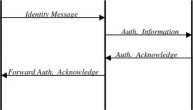5441337393
14
IJCSI International Journal of Computer Science Issues, Vol. 7, Issue 3, No 9, May 2010 www.IJCSI.org
V_Hp,K: VLR-HLR link s private key V_Hft,K: VLR-HLR link\s public key
M_VPrK: MS-VLR link's private key M_VPuK: MS-VLR link‘s public key
Hmc: HLR privale key
Hp„k: HLR public key
M,,k: Mobile station's private key
UMTS an integrity key (IK) for the integrity of signaling messages. These two keys are concatenated, encrypted with VLR’s public key (MS_VFuK) and are sent to the VLR in the Authenlication Response message. After the authentication is successful, the data and signaling information are encrypted with the keys SK and IK to preserve the confidentiality and integrity of both the data and signals.
The public key cryptographic approach discussed in the above paragraphs is an obvious way of authentication and securing the communication especially when it is used in financial transactions like e/m-commerce. In this approach, five messages are exchanged to authenticate the user and to share the keys which brings signaling overhead. In this approach, the user (MS) is authenticated by the network before giving the service but it does not authenticate the network. One can rely only on the fact that both, the MS and the HLR, have the same secret key Ki. This can be considered a weak network authentication, but it will fail if the key Ki is stolen or accessed by a third party. The denial-of-service attack is possible if the attacker changes the authentication signaling (signal integrity). In the next section, we propose a generał solution with reduced signaling for all the three systems GSM, GPRS and UMTS to reduce the drawbacks discussed above.
6. Authentication and Encryption in GSM, GPRS and UMTS Using Public Key Cryptography
Due to slow data rates, the public key encryption offers, it is not encouraged to be used for communication encryption. Instead, it is preferred for authentication and secret key distribution to be used in symmetric key encryption of the communication. To encrypt the data and signaling, special secret and integrity keys like SK and IK may be used respectively for communication encryption and signaling integrity.
In this section, we present a solution based on public key cryptography. This relies on the same concept of public-private keys as mentioned in the section 5. The three main entities, MS, VLR and HLR, are using four pairs of public-private keys as shown in Figurę 4(a).
These three entities exchange four messages with each other as shown in Figurę 4(b). The detail of the elements in each of these messages is
Idenlily Message = EM_Vl« (iKlISKllRAND) II EHp,k (IMSIII Ki) Authenlication Information = EHnK(IMSllKi)
Figurę 4(a). Sel of public keys used
MS VLR HLR

Figurę 4(b). Authenticalion process using public key cryptography
Authentication Acknowledge = MpuK
Forward Authentication Acknowledge = Em,,* (RAND)
The symbol ‘II’ represents the concatenation of two elements. The MS creates secret keys SK, IK and a random challenge RAND. It starts the authentication exchange by sending an Identity Message to the visited VLR. This message includes concatenation of RAND, SK and IK encrypted with public key M_Vpuk- The IMSI and Ki encrypted with public key HPuk is also part of the Identity Message as shown in Figurę 4(b). Unlike the approach in [8], the secret keys SK and IK are sent in the first message.
The VLR uses the corresponding private key M_VPrK to decode the part of the message and extract the needed information RAND, SK and IK. The VLR forwards the rest of message (Em>uK(IMSIIKi)) unchanged in Authentication Information message to the HLR. The keys
Wyszukiwarka
Podobne podstrony:
12 IJCSI International Journal of Computer Science Issues, Vol. 7, Issue 3, No 9, May 2010 www.IJCSI
15 IJCSI International Journal of Computer Science Issues, Vol. 7, Issue 3, No 9, May 2010 www.IJCSI
IJCSI International Journal of Computer Science Issues, Vol. 7, Issue 3, No 9, May 2010
IJCSI International Journal of Computer Science Issues, Vol. 7, Issue 3, No 9, May 2010
International Journal of Computer Science & Engineenng Survey (UCSES) Vol.6, No.2, Apnl 2015Secu
International Journal of Computer Science & Engineenng Survey (UCSES) Vol.6, No.2, April 2015 Th
International Journal of Computer Science & Engineenng Survey (UCSES) Vol.6, No.2, April 2015 co
International Journal of Computer Science & Engineenng Survey (UCSES) Vol.6, No.2, April 2015 Th
International Journal of Computer Science & Engmeenng Survey (UCSES) Vol.6, No.2, April 2015 sev
International Journal of Computer Science & Engmeenng Survey (IJCSES) Vol.6, No.2, April 2015 4.
International Journal of Computer Science & Engmeenng Survey (IJCSES) Vol.6, No.2, April 2015 4.
International Journal of Computer Science & Engmeenng Survey (UCSES) Vol.6, No.2, April 2015 Fig
International Journal of Computer Science & Engmeenng Survey (UCSES) Vol.6, No.2, April 20157.
International Journal of Computer Science & Engineenng Survey (UCSES) Vol.6, No.2, April
International Journal of Computer Science & Engineenng Survey (UCSES) Vol.6, No.2, April 2015 1.
International Journal of Computer Science & Engineenng Survey (UCSES) Vol.6, No.2, April 2015 Fo
International Journal of Computer Science & Engmeenng Survey (UCSES) Vol.6, No.2, April 2015 2.2
International Journal of Computer Science & Engmeenng Survey (IJCSES) Vol.6, No.2, April 2015 2.
International Journal of Computer Science & Engmeenng Survey (IJCSES) Vol.6, No.2, April 2015 GS
więcej podobnych podstron